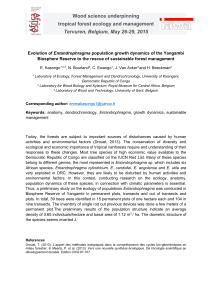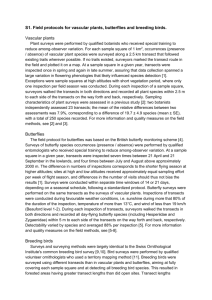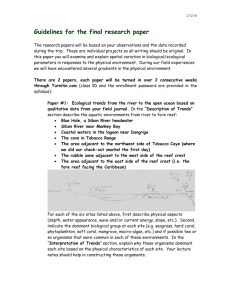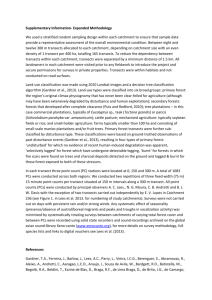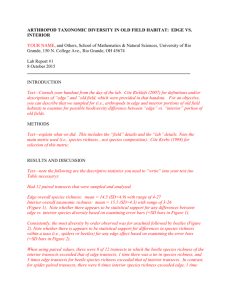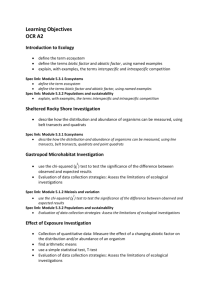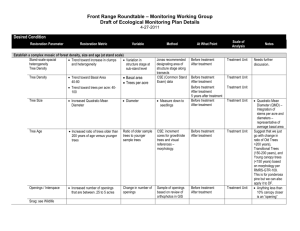2003Oasis
advertisement
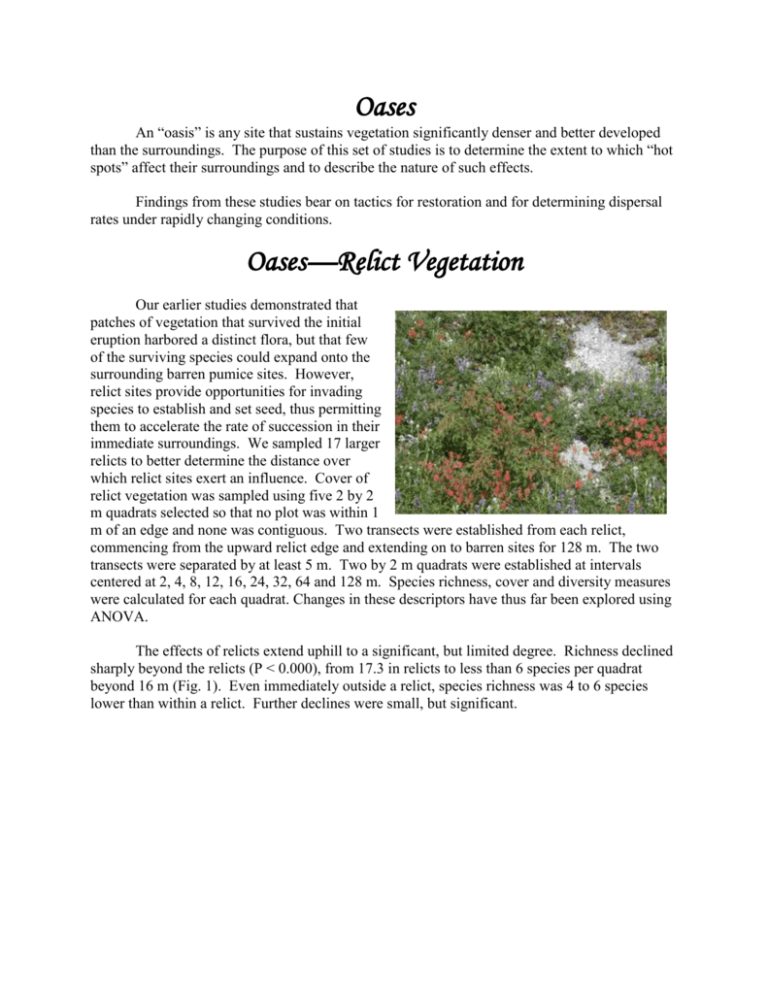
Oases An “oasis” is any site that sustains vegetation significantly denser and better developed than the surroundings. The purpose of this set of studies is to determine the extent to which “hot spots” affect their surroundings and to describe the nature of such effects. Findings from these studies bear on tactics for restoration and for determining dispersal rates under rapidly changing conditions. Oases—Relict Vegetation Our earlier studies demonstrated that patches of vegetation that survived the initial eruption harbored a distinct flora, but that few of the surviving species could expand onto the surrounding barren pumice sites. However, relict sites provide opportunities for invading species to establish and set seed, thus permitting them to accelerate the rate of succession in their immediate surroundings. We sampled 17 larger relicts to better determine the distance over which relict sites exert an influence. Cover of relict vegetation was sampled using five 2 by 2 m quadrats selected so that no plot was within 1 m of an edge and none was contiguous. Two transects were established from each relict, commencing from the upward relict edge and extending on to barren sites for 128 m. The two transects were separated by at least 5 m. Two by 2 m quadrats were established at intervals centered at 2, 4, 8, 12, 16, 24, 32, 64 and 128 m. Species richness, cover and diversity measures were calculated for each quadrat. Changes in these descriptors have thus far been explored using ANOVA. The effects of relicts extend uphill to a significant, but limited degree. Richness declined sharply beyond the relicts (P < 0.000), from 17.3 in relicts to less than 6 species per quadrat beyond 16 m (Fig. 1). Even immediately outside a relict, species richness was 4 to 6 species lower than within a relict. Further declines were small, but significant. Fig. 1. Mean species richness along transects uphill from relicts (12 m2 quadrats) to distant barrens (4 m2 quadrats) (Heavy black diamonds). Several individual transects are also shown for comparison. The reduction in cover was equally dramatic (Fig. 2). Cover dropped quickly outside the refuge (ANOVA, P<0.000). Beyond 16 m, there is no discernable effect on cover, an effect that is more pronounced when mosses are excluded. Fig. 2. Mean cover on transects uphill from refuges (Heavy black diamonds). Several individual transects are also shown for comparison to indicate the variability. In 2003 we sampled in more detail along 10 additional transects leading from relicts onto pumice. The twin purposes were to determine if the relict effect noted in earlier studies had expanded and whether or not pumice plots distant from relicts were becoming more similar to those immediately adjacent to relicts. Species richness declined, as expected. Plots within 3 m (1 to 3 m) of relicts had over 10 species per m2, while those 7 to 9 m had 7 species. No plot beyond 8 m differed significantly. The richness effect continues to be limited to within a few meters of the relicts (Fig. 9A). Cover declined dramatically (Fig. 9B). The close plots had three to four times the cover of other plots, none of which differed significantly from one another. However, while data collected in 1997 indicated a mean cover of 4% in this area, values in 2003 were two to three times higher, indicating substantial development of at least some species in more isolated places. No measure of diversity differed significantly n this transect, though sites adjacent to the relicts had the highest H' values. Fig. 3. A. Mean species richness and B. Mean cover along transects uphill from relicts. Each bar represents the mean of 10 4m2 plots. A. A B. B Similarity among the plots indicated that sites adjacent to relicts continued to be strongly affected by colonization from the relicts. The mean percent similarity between 2 m plots and 8 m plots was 34%, dropping to 22% when compared to the distant plots. In contrast, 8 to 16, 16 to 64, and 64 to 128 m sites were all more similar, despite the greater distance between them (39 to 44%). When paired t-tests were conducted among the similarities for the 10 transects, the similarity between the 2 m and 8 m plots was significantly lower than that between 8 m and 16 m samples (P<0.005). This suggests that the relicts have a strong impact on immediately adjacent plots, but that this influence is very weak beyond 10 meters. Oases—Pothole Vegetation Due to greater soil moisture, protection from wind and an enhanced ability to collect and retain seeds, pothole vegetation developed more quickly than surrounding pumice barrens. All potholes on the margins of the pothole region were selected and transects leading from each to exposed sites were established. Cover in 1-m2 quadrats was recorded at 1, 2, 3, 4 (noncontiguous), 8, 12, 16 and 32 m. Changes in richness, cover and diversity (E and H’) along the transects were calculated and the distribution of individual species described. Transects leading from high cover potholes (more than 20% cover) were compared to those from sparsely vegetated potholes to determine if any effects were more pronounced. There were 38 transects radiation from 26 potholes. The immediate surroundings of potholes had higher cover than more distant sites. Cover in the first 8 m was significantly higher than cover in plots 12, 16 and 32 m distant, but the effects were small. Only m 32 was significantly lower than any plot within 8 m. However, comparisons between low cover potholes and high cover potholes revealed that the dense potholes had a greater effect on the surroundings. Cover within 4 m of dense potholes was significantly higher than the comparable quadrats near sparse potholes (t=2.67, P<0.01). By combining quadrats 1 to 4 (near), and 8 and 12 (moderate) and comparing these composites with more distant quadrats, I found that the low cover plots showed no trend, while the quadrats near high cover plots were significantly higher in cover than the more distant ones. These comparisons are summarized in Fig. 4. The ANOVA of transects from dense potholes showed that there was a significant decline in cover (P < 0.05), while there was no trend in transects form sparse potholes. The spikes in cover in mid-distance result from dense patches of vegetation encountered in some transects. Fig. 4. Cover along pothole transects. Quadrats 1 to 4 and 8 and 12 were pooled. Structure of the samples changes moderately with distance. The D statistic showed a distinct, significant trend with dominance decreasing with distance from potholes (P <0.02). This trend was observed with equitability and H’, but neither of these was significant. ANOVA comparisons were made after dividing transects into those from Sparse and those from Dense potholes. None of the sparse transects showed significant trends. However, D (P <.01) and H’ both showed increasing complexity with distance, reflecting reduced dominance by a few species, notably lupines. Evenness showed a similar, but not significant, trend. Oases—Wetland Vegetation Wetlands established soon after substrates stabilized. Several forms of wetlands occur. We conducted two sets of studies concerning the potential effects of wetlands. The first sampled linear wetlands dominated by willows and associated with either springs or substantial snowmelt. Sixteen wetlands supported by subsurface water, and thus forming isolated oases in the pyroclastic zone, were sampled using transects originating in the wetland. Cover of each species was determined in 1-m2 quadrats sampled at 1, 2, 3, 4, 8, 12, 16, and 32 m along 2 to 3 transects. Quadrats were placed on alternating sides of the transect line. These data revealed little effect of wetlands beyond 2 m. Ten wetlands were sampled using transects parallel to the water course. Parallel transects were established at 1, 5 and 20 m in the hopes of detecting wetland influences. Thus far, there is little evidence for an effect beyond 5 meters. Linear wetland effects may be confounded by recent advances in lupine populations near most of our samples. The zone immediately outside the influence of the wetland averaged 44% cover, significantly greater than the wetland understory (27%). The wetlands are dominated by Salix cover (45%). Five m from the wetland, cover was significantly lower (31%), and thereafter there were no differences among the transects. These preliminary analyses suggest that any affect of wetlands on the surrounding vegetation is very limited, and that within one meter is primarily due to the lack of shade, not greater soil resources.
